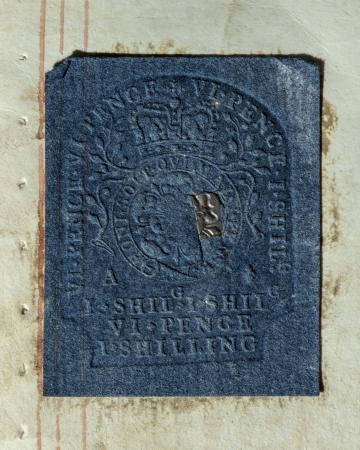July has been an important date in the history of the Hungerford Deed, our recently acquired legal document that is a record of the origins of Smithsonian founding donor James Smithson’s fortune. Three of the major dates in the Hungerford family legal history contained in the Deed occur in July. To celebrate the Deed’s 233rd birthday on July 28, I am taking my lead from birthday celebrations of my own childhood, when school friends and my younger sisters would share compliments as part of their birthday greetings. I'll feature a couple of the unique things I love about the Deed and delve into some of those fascinating related details. Then, we’ll wind the post up with some of my own wishes for the Deed on its birthday and preview where we hope to see the Deed in the next few years.
A few of my favorite things
Historical synchronicities
One of the things I have loved about digging into the Deed is the opportunity to discover where in history it belongs. A careful review of Smithson’s life and the dates recorded in the Deed show that Smithson’s Oxford education almost precisely overlapped his mother’s Chancery Court lawsuit against his aunt (details of this are in my first post about the Deed). The young man would have matriculated mere months after she filed her suit, and the case would drag on throughout his education—perhaps casting a social pall across his time at Pembroke College, and only lifting after his degree was complete. While it is useless to speculate, it’s hard to imagine that a public Chancery case would not attract attention from the gossipy upper-crust Smithson mingled with.
Just as James Smithson’s life was punctuated by his family history, the Deed also intersected wider world events, particularly with the American Revolution. Though Smithson never visited North America, his older half-brother, Hugh Percy, served in the British forces occupying Boston, and fought in the Battles of Lexington and Concord as well as Long Island. (Smithson never met his brother, but I imagine he would have followed the events from both a general interest in the war and from a personal fascination with the family who never acknowledged him.) In addition, the Deed was scribed and sealed at the end of July 1787, just as the Constitutional Convention was sitting in Philadelphia. It’s fascinating to think that at the same time colonial leaders were drafting our form of government, James Smithson’s mother was acquiring land wealth that would pass to him, and eventually, lead to a national museum for this nascent country.
Stamps and seals
Another connection with the American Revolution is the use of British tax stamps found on each parchment sheet of the Deed. As many a U.S. student can recount, these stamps drew the ire of the American colonists as they pushed back against what they perceived were oppressive taxes from Great Britain and ultimately engaged in a war for independence. The Stamps Act of 1694 placed a duty on all legal documents; an official stamp indicated that payment was made and that the documents were now legally enforceable. For parchment or vellum documents like the Deed, an embossed paper stamp was applied with glue and secured with a strip of tin passed through small slits in the stamp and underlying document. The tin strip’s ends were covered with another adhered piece of paper decorated with the contemporary monarch’s royal cypher. The Deed’s stamps are general purpose and have a fixed value of one shilling and sixpence (about USD $25 in 2020); when the tax for all sixteen pages of the Deed are added up, the value is roughly equivalent to the yearly income from some of the properties listed within the Deed.

Birthday wishes for the Deed’s future
Knowing more about the Deed has helped me shape our next plans for its long-term care. Understanding more about the tax stamps, for example, assists me in identifying the materials used in their fabrication, which will dictate my approach to stabilizing and storing them. Delving into the content of the Deed has also sharpened my desire to learn more through continued research, as well as focused my specific searches.
Treatment plan
In my initial, basic intervention (which you can read about in my original treatment post), our emphasis was on relaxing the parchment sufficiently to allow it to lay flat and reduce tension in the overall document. We also performed light surface cleaning. My colleague, preservation coordinator Alison Reppert Gerber then constructed a temporary housing for the Deed. Our next step will be to mend and stabilize the damaged areas of the two outer parchment membranes, in concert with additional humidification and flattening of all sixteen pages of the document. Stabilization of the wax seal and potentially replacement of the detached royal cypher—bearing paper seals on the reverse of the tax stamps is under consideration, as is further analysis of the materials of the Deed, and the construction of a custom clamshell enclosure.
Housing ideas
The goal of the enclosure is to facilitate safe handling and long-term protection of the Deed. One style of housing I have imagined recesses the document into a deep tray to protect the edges, particularly the vulnerable head and the tail-edge wrapper. A restraining plate built into the lid of this enclosure would keep pressure on the Deed and encourage it to lay flat. The current enclosure accommodates an archival paperboard tube to support and help the membranes drape rather than bend as the document is treated or, in the future, used by researchers. Being able to see Smithson’s signature on the reverse is compelling, and a window might be cut out of the bottom of the box to facilitate viewing. If the box utilizes a pressure plate in the lid, it would be feasible to flip the box and view the signature without removing the Deed from its enclosure.

Research at the UK National Archives
To further supplement our knowledge of the Deed, and of the Hungerford family, I hope in the relatively near future to visit the UK National Archives and explore some of their collections from this period. Heather Ewing undertook research there and uncovered several documents related to James Smithson’s Hungerford family; the additional insight gained from the recitals in the Deed has allowed me to identify what I believe is the original lawsuit Elizabeth Macie brought against her sister in 1782 to enforce the agreed-upon partition of lands.
Dear Deed—there is so much more to say about you, but this peek into your past has been delightful. May you be with us at least another two hundred and thirty-three years!
Related Resources
- James Smithson, Founding Donor, Smithsonian Archives website
- “'To Have and to Hold’: Parsing the Legal Framework of the Hungerford Deed,” by William Bennett, The Bigger Picture, Smithsonian Institution Archives
- “I.D. This! Parchment,” by William Bennett, The Bigger Picture, Smithsonian Institution Archives
- The Stamp Act, Colonial Williamsburg
Produced by the Smithsonian Institution Archives. For copyright questions, please see the Terms of Use.

Leave a Comment